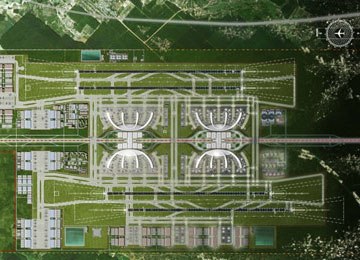


JAC utilizes available statistical data on regional/national passenger and cargo air transportation to ascertain their characteristics and movement patterns. Understanding where people and cargo move at the macro level can assist in scheduling and operations for more efficient airport administration and development.
Airline marketing campaigns, social changes and economic factors all have an impact on air travel patterns and air cargo volumes. JAC analyzes these trends to predict how airport use will change so airports can make the adjustments needed to meet the new demand.
Local customs, economics and other factors can affect how people use an airport. Using a SWOT (strengths, weaknesses, opportunities and threats) approach, JAC considers cultural factors, demographics and regional socioeconomics in analyzing how travelers use an airport, and develop an operation strategy so the airport can better serve its customers.
The selection of a site is the most important step in building an airport. Taking air travel demand, engineering and safety concerns into consideration, JAC assists in finding a site suitable for the development of a new airport.
To understand how large the airport and its facilities must be, first JAC considers how they should function to accommodate the estimated future international and domestic travel demand. This is followed with a demand/capacity analysis to calculate the size of airport facilities.
A layout is created for the airport that includes all of the main functional parts of the facility, including the runways, parking facilities, terminal areas, air traffic control tower, ground lights, fire safety and security.
To estimate the possibility of delays/cancellations of flights, a calculation is made based on weather conditions, including the wind speed and direction, cloud height and visibility.
Aircraft flight operation procedures are examined taking into account locations of mountain ranges, high structures, noise-sensitive areas, prohibited airspaces, etc. to ensure safe and efficient approaches and take-off to/from an airport as well as enroute.
An environmental impact assessment is made for the airport development project based on any national or regional regulations and industry standards. The assessment includes the effects the airport construction and operations will have on the local natural and social environment and a set of proposals of strategies/measures to alleviate the impact.
Aircraft noise contours are mapped out to accurately ascertain the current level of aircraft noise and estimate the future level. With this knowledge, noise control measures are recommended to control noise now and in the future.
There are a number of ways to increase the number of aircraft operations an airport can handle. JAC analyzes multi-runway operation procedures, layout, rapid exit taxiways and other elements to improve efficiency. We also examine the movement patterns of aircraft and ground vehicles to coordinate and streamline.
Using powerful computer simulation software, JAC models airport traffic, including buses, taxis, private cars and cargo trucks. Through these simulations, road and intersection design can be improved to streamline on-site traffic.
Due to the public nature of an airport construction project, project assessments are required to address various concerns. JAC takes local cultural concerns and regulatory considerations into account when making assessments, which may include one at the time of project approval, an interim assessment and a final assessment after the project is complete.
A cost benefit analysis is provided for major facility projects to ascertain the projected income and operational costs once running.
Based on an assessment of the risks that a large-scale earthquake would entail, JAC identifies critical areas, suggestions solutions and creates a prioritized proposal with proactive measures to reduce potential earthquake damage.
When implementing a major public project, transparency and fairness are critical to ensure public trust. Starting at the conceptualization and planning stages, JAC holds informational meetings and releases project information to encourage approval from residents and other stockholders. We also encourage feedback which we incorporate in our operations to further build a cooperative relationship.
| Back |